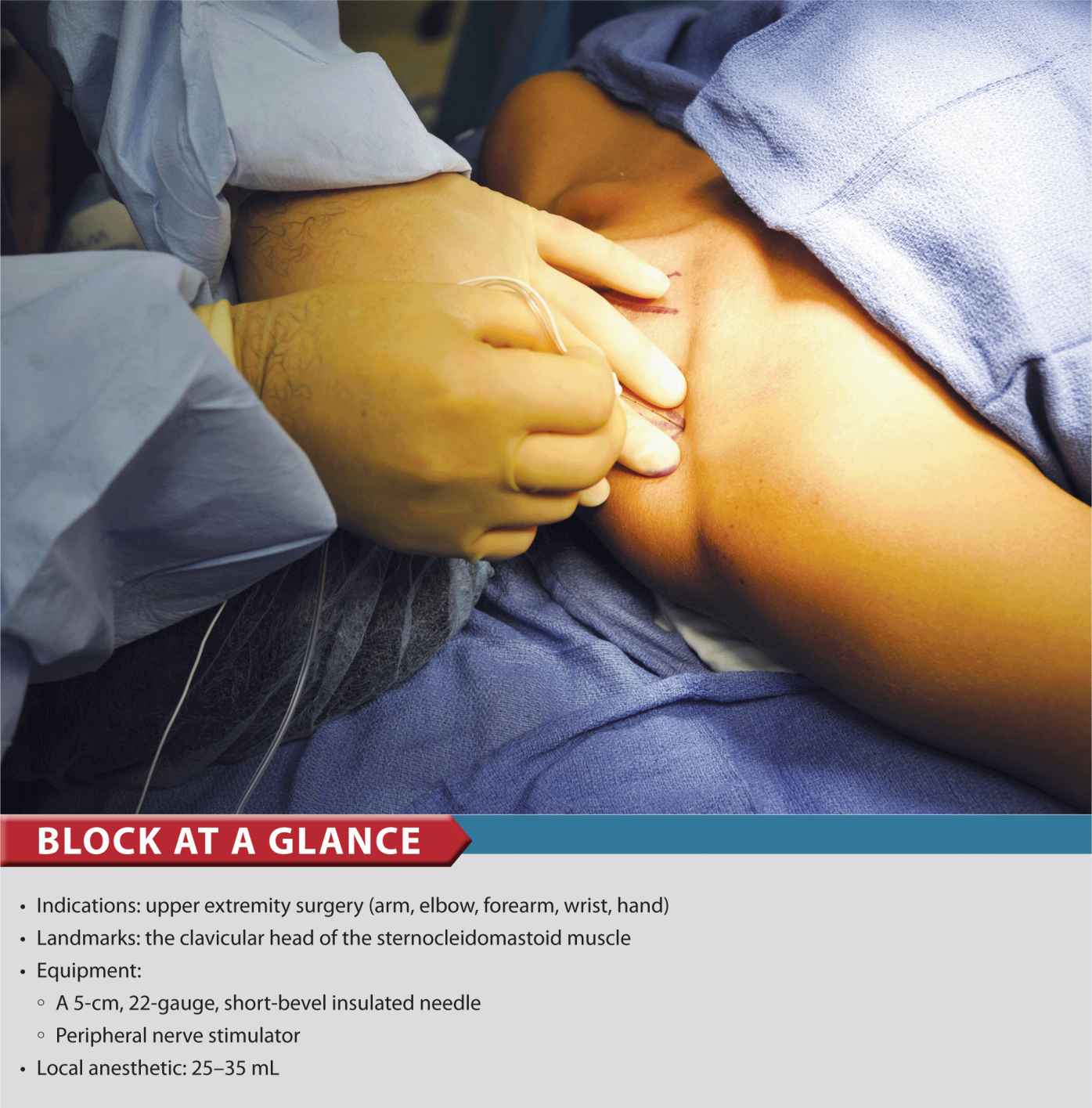Supraclavicular Brachial Plexus Block

FIGURE 13-1. Insertion of the needle in the supraclavicular brachial plexus block. The needle is inserted lateral to the insertion of the clavicular head of the sternocleidomastoid muscle.
Supraclavicular Block
General Considerations
The supraclavicular approach to the brachial plexus characteristically is associated with a rapid onset of anesthesia and a high success rate. The first percutaneous supraclavicular block was performed by Kulenkampff in Germany in 1911, reportedly on himself. A few months after, Hirschel described a method of brachial plexus with an axillary approach. In 1928, Kulenkampff and Persky published their experiences with a thousand blocks without apparent major complications.
Kulenkampff’s technique required the patient to be in the sitting position. The needle insertion was above the midpoint of the clavicle in the direction of the spinous process of T2 or T3. Unfortunately, this medial orientation of the needle was associated with a risk of pneumothorax, which eventually became the reason for the supraclavicular block to fall into disfavor in many centers. Since then, many modifications to the original technique were proposed to decrease the risk for pneumothorax. The technique described in this chapter takes into account the location of the dome of the pleura to reduce the risk for pneumothorax.
The advantages of a supraclavicular technique over other brachial plexus block approaches are its rapid onset and complete and predictable anesthesia for entire upper extremity and particularly, hand surgery. The introduction of ultrasound guidance to regional anesthesia in the last decade has resulted in significant renewed interest in the clinical application of the supraclavicular block, as well as a greater understanding of its mechanics.
Functional Anatomy
The supraclavicular block is often called the “spinal anesthesia of the upper extremity” because of its ubiquitous application for upper extremity surgery. The reasons for its high success rate are in its anatomic characteristics. The block is performed at the level of the distal trunks and origin of the divisions, where the brachial plexus is confined to its smallest surface area (Figure 13-2A). The three trunks carry the entire sensory, motor, and sympathetic innervation of the upper extremity, with the exception of the uppermost part of the medial side of the arm (T2). The densely packed divisions, in contrast, carry a similar amount of innervation in a slightly larger surface area, but there is a larger surface of absorption. Another important anatomic feature of the supraclavicular block is the presence of the subclavian artery in front of the lower trunk and its divisions (Figure 13-2B). To increase the chance of blocking C8-T1 dermatomes it may be beneficial to insert the needle in the proximity of the lower trunk and make it the focal point of injection.

FIGURE 13-2. (A) Anatomy of brachial plexus about the clavicle. Shown are upper (U), middle (M), and lower (L) roots of the brachial plexus emerging between anterior (ASM) and middle (MSM) scalene muscles. Phrenic nerve (PhN) is shown descending on the anterior-medial surface of the anterior scalene muscle. Other shown anatomic details of importance are vertebral artery (VA), suprascapular nerve (S), trapezius muscle (TrM), and subclavian artery (SA). Note the intimate relationship of the brachial plexus trunks to the subclavian artery as they both pass underneath the clavicle. (B) Relationship of the arterial vasculature and the brachial plexus at the level above the clavicle.
The sternocleidomastoid muscle inserts on the medial third of the clavicle, the trapezius inserts on the lateral third, and the neurovascular bundle passes underneath the middle third, which includes the midpoint of the clavicle. During a supraclavicular block, the pleura potentially can be breached either at the pleural dome (more likely) or through the first intercostal space.
A practical knowledge of the anatomical position of the pleura is important to decrease the risk of pneumothorax. The pleural dome is contained within the concavity of the first rib. Because the first rib crosses under the junction between the medial and middle thirds of the clavicle (Figure 13-3), its path coincides with the insertion of the sternocleidomastoid muscle, which inserts on the medial third of the clavicle. Therefore, the lateral insertion of the sternocleidomastoid muscle on the clavicle can be used as a landmark for the location of the first rib and of the lateral edge of the dome of the pleura. The first intercostal space, in contrast, is for the most part infraclavicular, and consequently it should not be reached during a supraclavicular block.

FIGURE 13-3. Radiocontrast image of the mixture of local anesthetic and radiopaque solution injected in the supraclavicular brachial plexus. The contrast is shown descending from the lower aspect of the clavicle toward the axillary fossa.
Stay updated, free articles. Join our Telegram channel

Full access? Get Clinical Tree








